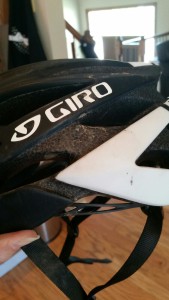
Concussions have recently become a very popular topic in the media and public due to the latest research in the long term symptoms associated with concussions. Football comes to everyones mind first and foremost, but did you know that soccer and cycling have very high rates of CONCUSSIONS? An estimated 1.6-3.8 million sports- and recreation-related concussions occur in the United States each year. During 2001-2005, children and youth ages 5-18 years accounted for 2.4 million sports-related emergency department (ED) visits annually, of which 6% (135,000) involved a concussion.
This leads us to a local TRIATHLETE’S story from the past week, and the dangers of a concussion.
During a routine training ride, a current patient and friend of CORE, had a biking accident. She quickly called a family member to inform them of the incident, be she could not remember where she was riding, where she was parked, or even how she got where she was. She reported the she did NOT hit her head, or did not lose consciousness. She felt off, and a bit light headed.
After regaining some semblance of her bearings, she gave CORE a call for a concussion screen. Upon arrival to our clinic, she appeared in a different temperament, with malaise, and lethargy uncommon for this patient. A few scrapes and such were obvious but not abnormal for a bike crash.
Her visual tracking was assessed as it would be on the Football field. Cranial nerve testing was conducted. Orientation, personal information, problem solving/light memory tasks were given with mixed results. She did not report HEAD PAIN or Headache at the clinic upon arrival. Her PUPILS where dilated, did respond to light, but diminished compared to the norm and the expected reaction.
As more tests where given, the holes become more obvious. She had a concussion, her symptoms however were NOT severe, but still positive. We were SURE that had hit her head.
She was deemed safe enough to drive home without music or distraction, and advised to take off work to let her brain recover from Injury. Upon inspection of her helmet upon arrival back at home it was clear there was a HEAD IMPACT. NOTE-Fewer than 10% of sport related concussions involve a Loss of Consciousness.
There was obvious damage to the helmet, but without any memory of that part of the incident. With resting of her brain activity and decreasing normal stimulus, with loved ones/clinicians observing her behavior and symptoms, she will recover fully. Its import to remember how Dangerous it can be to have a CONCUSSION, and the disorientation that can follow. Even more DANGEROUS is ignoring the symptoms. Headache (85%) and Dizziness (70-80%) are most commonly reported symptoms immediately following concussions for injured athlete. Estimated 47% of athletes do not report feeling any symptoms after a concussive blow.
Some research has suggested that females can be nearly 2x more likely to suffer from a concussion.
In the coming days, she will need to let her brain RECOVER and is advised against all exercise for one week following cessation of all symptoms related to her neurological condition. Graded exercise return gradually is a must to avoid LONG TERM damage, or elongation of symptom patterns.
Stress and stimulation from higher level brain activities are to be Minimized; Should you work? No! Should you go to school? No! Should you play on your Phone? No!
Moral of the STORY; If a loved one is acting strange or different after a trauma to the body, big or small. Get them CHECKED. If needed and MRI may be necessary, but even a negative MRI result does NOT mean you didn’t have a concussion. A graded return to stimulus exposure should be followed in a regimented plan of care.
Please do NOT take Concussions Lightly. After all, brain is a TERRIBLE thing to waste…
-Dr. Mark Rathjen PT, DPT, CSCS, Dr. Claire Rathjen, PT, DPT, SCS, CSCS
